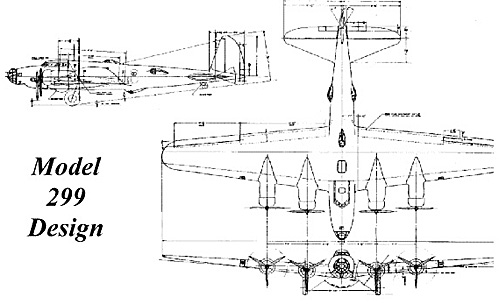Work on the new plane progressed rapidly and its first flight took place July 28, 1935. On hand at its unveiling were a number of reporters, one of which impressed by its size commented that the 299 looked like a "flying fortress." The term was also used in an article about the new bomber in a Seattle paper the same day. The name stuck -- no doubt to Boeing's delight.
The Model 299 was one of the largest aircraft of its day and required special features to make it work properly. For example, the surface area of the elevators and rudder was so large that there were fears they might be damaged by flapping about in a high wind. A special locking mechanism was installed to hold them firmly in place when the plane was parked.
Boeing test pilot Les Tower ran the 299 through its paces over the next few weeks and post production adjustments were completed in time for the competition the Army had set up to decide whom to award the 220 plane contract to. On August 20th Tower flew the 299 from Seattle to Wright Field in Ohio. Along the way the 299 set a new long distance speed record at 232 miles per hour, most of which was done on autopilot. This performance greatly impressed the AAC. During the subsequent weeks their enthusiasm for the plane increased as it became obvious that the 299 exceeded all the Army's expectations. Boeing's entry was clearly the plane of choice.
Tragedy struck on October 30th as the competition was drawing to a close. The Boeing test crew forgot to unlock the elevators and rudder on the 299. Once airborne, the lack of the control surfaces rendered the plane uncontrollable and the 299 crashed within moments of takeoff, killing 2 of the test crew including Tower. Unable to complete the full series of tests, the 299 was disqualified and the contract awarded to the markedly inferior Douglas B-18. If the AAC was unhappy with the outcome, it spelled near disaster for Boeing. The loss of the contract, the plane and their test pilot, sent the Washington state company into a major financial crisis. For the rest of the year the Army tried unsuccessfully to have additional funds appropriated for the purchase of Boeing's new plane, but they consistently met opposition. One critic characterized the 299 as "too much plane for a man to handle." Then in January 1936 the Army received approval to purchase 13 planes designated as the Y1B-17. For Boeing it was not the financial windfall they had once hoped for, but it was enough to keep the stricken company financially afloat.

More B-17 Flying Fortress
-
B-17: Introduction
B-17: The 299: Triumph and Disaster
B-17: Y1B-17
B-17: The Fortress I
B-17: The Pacific
B-17: Europe
B-17: Gotterdammerung
Back to Cry Havoc #16 Table of Contents
Back to Cry Havoc List of Issues
Back to MagWeb Master Magazine List
© Copyright 1996 by David W. Tschanz.
This article appears in MagWeb (Magazine Web) on the Internet World Wide Web. Other military history articles and gaming articles are available at http://www.magweb.com